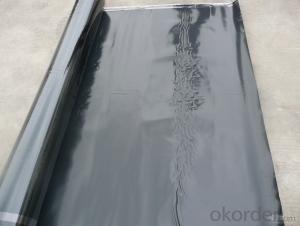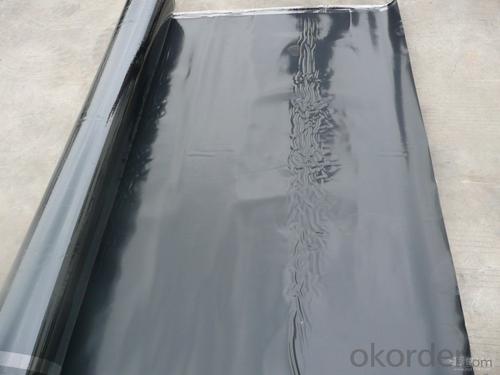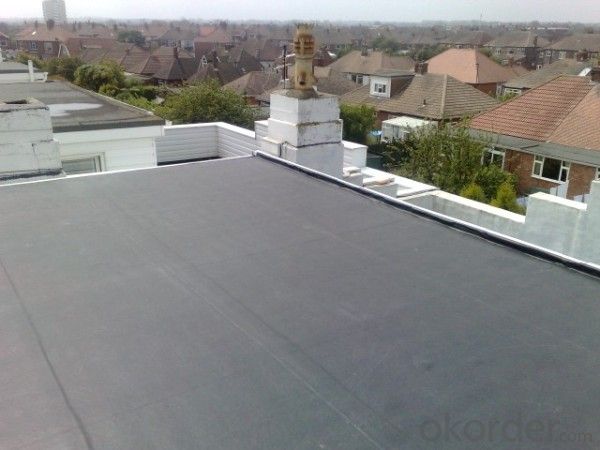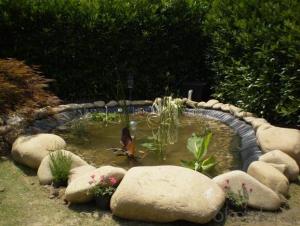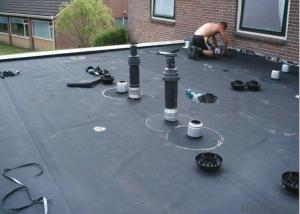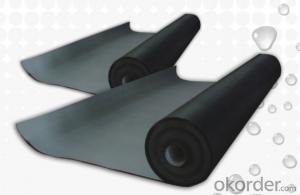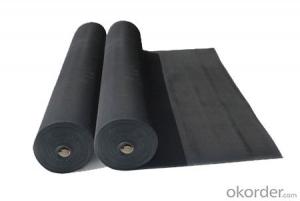EPDM Coiled Waterproof Membrane with High Tensile Strength
- Loading Port:
- Shanghai
- Payment Terms:
- TT OR LC
- Min Order Qty:
- 50000 m²
- Supply Capability:
- 5000000 m²/month
OKorder Service Pledge
OKorder Financial Service
You Might Also Like
EPDM Coiled Waterproof Membrane with High Tensile Strength
Description Of EPDM Coiled Waterproof Membrane with High Tensile Strength:
1. Excellent physical and mechanical performance, high tearing resistance;good deformation adaptability, high puncture resistance;
2. High aging resistance, high UV resistance, anti-acid & alkali;
3. Excellent low & high temperature resistance, innocuous, long life span;
4. Perfect water proof performance, seepage and humidity resistance.
Main Features of EPDM Coiled Waterproof Membrane with High Tensile Strength:
A.Polyester based SBS Modified Bitumen Waterproofing Membrane
a. Strong impermeability
b. High tensile strength, elongation, ability to adapt the grassroots shrinkage deformation and cracking
c. Puncture-resistant, broken resistant, tear-resistant
d. The corrosion resistance, resistance to mildew, weathering good
e. Construction convenient, hot-melt can be operated Four Seasons Construction, reliable joints
B. Fiberglass based SBS Modified Bitumen Waterproofing Membrane
a. High tensile strength, stability of a good size
b. High Temperature good performance
c. Damage resistance, corrosion resistance, resistance to mildew, weathering good performance
d. Good construction performance, reliable joints.
Specifications of EPDM Coiled Waterproof Membrane with High Tensile Strength:
| Material | EPDM Rubber |
| Size | 1.2m (width)*20m (length) or customized, weldable type 2.05m or 4m width |
| Thick | 1.2mm, 1.5mm, 2.0mm |
| Type | Vulcanized & Weldable |
| Pattern | Non-reinforced (homogeneous) |
| Certificate | ISO9001/14001 |
Applications of EPDM Coiled Waterproof Membrane with High Tensile Strength:
geomembrane used in groundsill of road, highway, railway and waterproof layer of swelling clay and wet collapsed loess.Geomembrane can be widely used in areas of garbage burying, waste disposal and underground construction projects.such as below:
- aquaculture ponds
- Ouchi root barrier membrane
- Floating baffles;
- Process wastewater
- Stormwater impoundments;
- Secondary containment;
- Spill containment
- Manure and biogas tanks and covers
- Potable water tanks and covers;
- Sludge Drying beds;
- Bioremediation covers & liners;
- Leachate ponds



IMages of EPDM Coiled Waterproof Membrane with High Tensile Strength:




FAQ of EPDM Coiled Waterproof Membrane with High Tensile Strength:
1. What are we supplying?
We are specialized in producing Colorful Asphalt Roof Shingle, SBS/APP modified bitumen waterproof membrane, Self adhesive bitumen waterproof membrane, PVC waterproofing membrane, EPDM rubber roofing membrane, Single Component Polyurethane Waterproof Coating, and Spray Polyurea Waterproof Coating
.
2. How Many years experience do we have?
We have been exported to more than 20 countries in the past 15 years.
3. How long do we usually reply your request?
We always reply our customer within 24 hours.
- Q: Can a waterproofing membrane be used in tunnels or underground structures?
- Yes, a waterproofing membrane can definitely be used in tunnels or underground structures. In fact, it is highly recommended to use a waterproofing membrane in these types of environments to prevent water damage and leakage. Tunnels and underground structures are particularly prone to water infiltration due to their location and exposure to underground water sources. The waterproofing membrane acts as a protective barrier, preventing water from seeping into the tunnels or structures and causing potential structural damage or compromising the safety of the space. It effectively creates a watertight seal, ensuring that the interior remains dry and free from water-related issues such as mold, corrosion, or degradation of materials. Additionally, waterproofing membranes are designed to withstand the unique challenges of underground environments such as high water pressure, ground movement, and exposure to harsh chemicals. Therefore, using a waterproofing membrane is not only possible but essential for maintaining the longevity and integrity of tunnels and underground structures.
- Q: Can a waterproofing membrane be installed by a DIYer?
- Yes, a waterproofing membrane can be installed by a DIYer. However, it is essential to follow the manufacturer's instructions carefully and have a basic understanding of the process. Additionally, the DIYer should possess the necessary skills and tools required for the installation. It is advisable to conduct thorough research and consider the complexity of the project before attempting it as improper installation can lead to ineffective waterproofing.
- Q: Can a waterproofing membrane be used for roofing?
- Yes, a waterproofing membrane can be used for roofing. In fact, it is a common choice for many roofing applications. Waterproofing membranes are designed to provide a protective barrier against water infiltration, which is essential for preventing leaks and water damage on roofs. These membranes are typically made of durable materials such as asphalt, synthetic rubber, or thermoplastic, which are resistant to water and can withstand harsh weather conditions. They are installed over the roof surface and provide a seamless, watertight layer that helps to keep the interior of the building dry and protected. Additionally, waterproofing membranes can be used on various types of roofs, including flat roofs, sloped roofs, and even green roofs. Overall, using a waterproofing membrane for roofing is an effective way to ensure long-lasting durability and protection against water damage.
- Q: Can a waterproofing membrane be used for vehicular traffic areas?
- Vehicular traffic areas can benefit from the use of a waterproofing membrane. These membranes are specifically designed to create a barrier that prevents water from seeping through and causing damage to surfaces. In areas like parking decks or driveways, it is crucial to protect the underlying structure from water infiltration, which can lead to corrosion, deterioration, and expensive repairs. By utilizing a waterproofing membrane that is specifically designed for vehicular traffic, the surface can be effectively safeguarded from water damage, as well as other potential contaminants such as oil and chemicals. These membranes are typically more durable and capable of withstanding the weight and impact of vehicles, ensuring long-lasting protection. Furthermore, certain waterproofing membranes even offer slip-resistant properties, making them suitable for areas where vehicles require traction. Nevertheless, it is important to seek guidance from a professional to determine the appropriate waterproofing membrane and installation method for specific vehicular traffic areas, taking into account factors such as traffic volume, load capacity, and climate conditions.
- Q: Is a waterproofing membrane resistant to abrasion?
- Yes, a waterproofing membrane is generally designed to be resistant to abrasion. The membrane is typically made of durable materials that can withstand friction and wear, ensuring long-lasting protection against water damage.
- Q: Can a waterproofing membrane be used for highway or road projects?
- Yes, a waterproofing membrane can be used for highway or road projects. Waterproofing membranes are commonly used in road construction to protect the underlying layers from water damage. These membranes act as a barrier against water infiltration, preventing water from seeping into the road structure and causing deterioration. They are typically applied on the bridge decks, tunnels, retaining walls, and other areas where water exposure is high. The waterproofing membrane helps to extend the lifespan of the road by preventing moisture-related issues such as cracks, potholes, and erosion. Additionally, it can enhance the durability and strength of the road structure, improving its resistance to environmental factors. Overall, the use of a waterproofing membrane in highway or road projects can provide long-term protection and ensure the longevity of the infrastructure.
- Q: Does a waterproofing membrane require any special maintenance?
- Yes, a waterproofing membrane does require some special maintenance. It is important to regularly inspect the membrane for any damages or signs of wear and tear. Additionally, periodic cleaning and removal of debris is necessary to ensure its effectiveness. Proper drainage and regular resealing or reapplying of waterproofing coatings may also be needed to maintain the membrane's longevity and functionality.
- Q: Can a waterproofing membrane be used for underground parking structures?
- Underground parking structures face a high risk of water infiltration because of their location and exposure to groundwater. To prevent potential damage, a waterproofing membrane is commonly used. These membranes act as a protective barrier, effectively stopping water from penetrating the structure and causing harm. Typically, they are applied to the exterior walls and floors of the underground parking structure to ensure a secure seal. In addition to safeguarding against water, these membranes also help prevent problems like mold growth, corrosion, and concrete deterioration caused by moisture. Thus, incorporating a waterproofing membrane is crucial for maintaining the long-term durability and functionality of underground parking structures.
- Q: Can a waterproofing membrane be used for stadiums or arenas?
- Yes, a waterproofing membrane can definitely be used for stadiums or arenas. In fact, it is highly recommended to use waterproofing membranes in these large-scale structures to protect them from water damage and leaks. Stadiums and arenas are often exposed to various weather conditions, including heavy rain and snow, which can potentially cause water infiltration into the structure. A waterproofing membrane acts as a barrier, preventing water from penetrating the building envelope and causing damage to the structural components, such as concrete or steel. It helps to maintain the integrity of the structure and prolong its lifespan. Additionally, waterproofing membranes can also provide protection against other forms of moisture, such as condensation and humidity, which can lead to mold growth and deterioration of materials. Therefore, using a waterproofing membrane is a crucial step in ensuring the durability and longevity of stadiums and arenas.
- Q: Can a waterproofing membrane be used on interior walls?
- Interior walls can indeed benefit from the use of a waterproofing membrane. These membranes are specifically designed to create a barrier against moisture, thus preventing any water from seeping into the surface and causing damage. Although their primary use is to protect exterior walls from rain and groundwater, they can also be employed on interior walls that are susceptible to moisture, such as bathrooms, kitchens, or basements. By applying a waterproofing membrane, you can effectively shield the interior walls against water damage, the growth of mold, and other issues related to moisture. However, it is crucial to keep in mind that the choice of the appropriate type of waterproofing membrane and the correct installation technique should be based on the specific requirements and conditions of the interior walls. To ensure proper application and long-lasting protection, it is highly recommended to seek the advice of a professional or follow the guidelines provided by the manufacturer.
Send your message to us
EPDM Coiled Waterproof Membrane with High Tensile Strength
- Loading Port:
- Shanghai
- Payment Terms:
- TT OR LC
- Min Order Qty:
- 50000 m²
- Supply Capability:
- 5000000 m²/month
OKorder Service Pledge
OKorder Financial Service
Similar products
Hot products
Hot Searches
Related keywords
